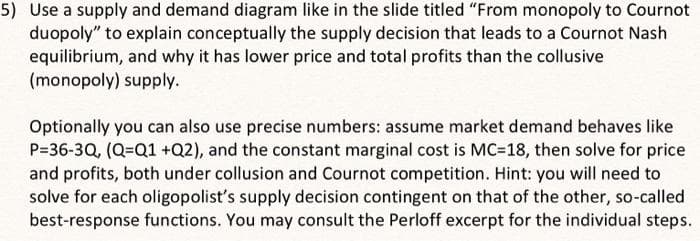5) Use a supply and demand diagram like in the slide titled "From monopoly to Cournot duopoly" to explain conceptually the supply decision that leads to a Cournot Nash equilibrium, and why it has lower price and total profits than the collusive (monopoly) supply. Optionally you can also use precise numbers: assume market demand behaves like P=36-3Q, (Q=Q1 +Q2), and the constant marginal cost is MC=18, then solve for price and profits, both under collusion and Cournot competition. Hint: you will need to solve for each oligopolist's supply decision contingent on that of the other, so-called best-response functions. You may consult the Perloff excerpt for the individual steps.
5) Use a supply and demand diagram like in the slide titled "From monopoly to Cournot duopoly" to explain conceptually the supply decision that leads to a Cournot Nash equilibrium, and why it has lower price and total profits than the collusive (monopoly) supply. Optionally you can also use precise numbers: assume market demand behaves like P=36-3Q, (Q=Q1 +Q2), and the constant marginal cost is MC=18, then solve for price and profits, both under collusion and Cournot competition. Hint: you will need to solve for each oligopolist's supply decision contingent on that of the other, so-called best-response functions. You may consult the Perloff excerpt for the individual steps.
Economics (MindTap Course List)
13th Edition
ISBN:9781337617383
Author:Roger A. Arnold
Publisher:Roger A. Arnold
Chapter25: Government And Product Markets: Antitrust And Regulation
Section: Chapter Questions
Problem 12QP
Related questions
Question

Transcribed Image Text:5) Use a supply and demand diagram like in the slide titled "From monopoly to Cournot
duopoly" to explain conceptually the supply decision that leads to a Cournot Nash
equilibrium, and why it has lower price and total profits than the collusive
(monopoly) supply.
Optionally you can also use precise numbers: assume market demand behaves like
P=36-3Q, (Q=Q1 +Q2), and the constant marginal cost is MC=18, then solve for price
and profits, both under collusion and Cournot competition. Hint: you will need to
solve for each oligopolist's supply decision contingent on that of the other, so-called
best-response functions. You may consult the Perloff excerpt for the individual steps.
Expert Solution
This question has been solved!
Explore an expertly crafted, step-by-step solution for a thorough understanding of key concepts.
Step by step
Solved in 3 steps with 2 images

Knowledge Booster
Learn more about
Need a deep-dive on the concept behind this application? Look no further. Learn more about this topic, economics and related others by exploring similar questions and additional content below.Recommended textbooks for you

Economics (MindTap Course List)
Economics
ISBN:
9781337617383
Author:
Roger A. Arnold
Publisher:
Cengage Learning



Economics (MindTap Course List)
Economics
ISBN:
9781337617383
Author:
Roger A. Arnold
Publisher:
Cengage Learning



Principles of Microeconomics
Economics
ISBN:
9781305156050
Author:
N. Gregory Mankiw
Publisher:
Cengage Learning

Principles of Economics, 7th Edition (MindTap Cou…
Economics
ISBN:
9781285165875
Author:
N. Gregory Mankiw
Publisher:
Cengage Learning

Principles of Economics (MindTap Course List)
Economics
ISBN:
9781305585126
Author:
N. Gregory Mankiw
Publisher:
Cengage Learning